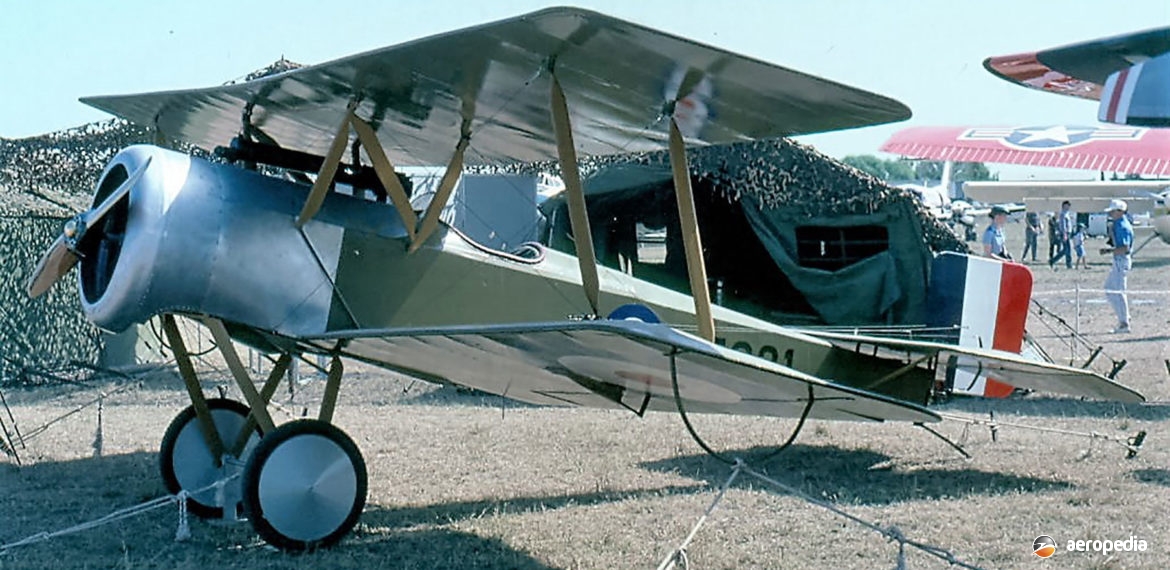Photograph:
Bristol Scout D replica S321 on display at RAAF Richmond, NSW in October 1991 (David C Eyre)
Country of origin:
United Kingdom
Description:
Single-seat scout monoplane
Power Plant:
One 75 kw (100 hp) Gnome Monosoupape nine-cylinder rotary engine
Specifications:
- Wingspan: 7.49 m (24 ft 7 in)
- Length: 6.3 m (20 ft 8 in)
- Height: 2.59 m (8 ft 6 in)
- Wing area: 18.39 m² (198 sq ft)
- Max speed at sea level: 161 km/h (100 mph)
- Max speed at 4,724 m (15,500 ft): 138 km/h (86 mph)
- Climb to 3,048 m (10,000 ft): 18 mins 30 secs
- Ceiling: 4,724 m (15,500 ft)
- Endurance: 2 hrs 30 mins
- Empty weight: 344 kg (760 lb)
- Loaded weight: 567 kg (1,250 lb)
Armament:
One 7.7 mm (0.303 in) Lewis machine gun, or a variety of other combinations such as
pistols, rifles, duck guns, grenades or light bombs
History:
The Bristol Scout was designed by Frank Barnwell, chief designer and engineer from 1915 to 1938 for the British & Colonial Aeroplane Company, being flown for the first time on 23 February 1914 by the Australian pilot, Harry Busteed. First public view of the aircraft was at the Aero Show at Olympia in London, UK on 16 March 1914. The prototype, known as the Bristol Scout A, proved quite promising and two military scout models known as the Scout B were delivered to the Royal Flying Corps in August 1914.
Subsequently 161 production examples were built as the Scout C, this model having an enlarged tailplane and elevators, and an increased rudder area.
In 1915 production aircraft received a further enlarged tailplane and elevator, and a further increase in the area of the rudder. Production machines so built were known as the Scout D, the final production model, and 210 were built.
A few Scout Fs were built but this model did not enter production.
The type was operated in the Aegean, Macedonia, Palestine and Mesopotamia and these aircraft flew from ‘HMS Vindex’ from November 1915. One (serial 3028), a Scout C, was attached to the upper wing of a Porte Baby flying boat with a view to being used to attack Zeppelins and it was experimentally successfully released on 17 May 1916.
The type saw service with the Australian Flying Corps (AFC) in Egypt where Scout C and Scout D models were operated by Nos 1 and 6 Squadrons, eventually being relegated to the training role. The type was also flown by Australians in England with the Royal Flying Corps at Tern Hill in Shropshire where No 6 (Training) Squadron was known as No 30 (Australian Training) Squadron, RFC. It is thought No 8 (Training) Squadron had some Scouts whilst based at Tern Hill when it was also known as No 30 (Australian Training) Squadron, RFC.
On 25 July 1915 Major L G Hawker of No 6 Squadron, RFC in a Bristol Scout C (serial 1611) was awarded the Victoria Cross (VC) for air fighting when he engaged and forced down three Albatross two-seat fighters. Hawker was born in the United Kingdom but always considered himself an Australian.
In January 1916 the Australian Government ordered a Scout for the Central Flying School at Point Cook, VIC and Bristol Scout Type D (serial 8976) fitted with an 80 kw (100 hp) Gnome Monosoupape engine was shipped on board the ‘SS Bakara’, arriving at Point Cook on 28 September 1916. Although allotted the Australian serial CFS-10, it carried the Royal Naval Air Service serial 8976 for most of its life. At one stage, however, it was noted with the serial CFS-4 painted on the rudder. This aircraft was one of a batch of 50 produced for the British Admiralty fitted with a Lewis machine-gun and a bomb-sight.
The aircraft was considered too advanced for trainee pilots and was usually flown by instructors. In October 1917 it set a record for the longest non-stop flight in Australia, flying 273 km (170 miles) from Melbourne, VIC to Albury, NSW in two hours, this being part of the Liberty Loan campaign during which the plan was to drop pamphlets over country towns. However, it turned over at Wagga Wagga, NSW, and had to be returned by motor transport. It is known the aircraft took part in a display at Flemington Racecourse in Melbourne not long after the war but the ultimate fate of this aircraft is not known, although it is believed to have been struck off strength in 1920.
A replica (non-flying) Bristol Scout D was built in Queensland. This aircraft was owned by Ipswich cartoonist, William Mitchell, and was obtained by Messrs K Woodrow and M Adams in January 1980. It was built with the intention of being flown and was fitted with a Volkswagen engine and named ‘Red Rosy’. However, it was not built with supervision of the Department of Aviation and could not be flown.
Although not an accurate replica, in March 1987 it was painted in the colour scheme of ‘8976’, fitted with a replica rotary engine, and placed on display at the Queensland Aviation Museum at Caloundra with other historic aircraft. Between December 1989 and May 1994 it was loaned to and placed on display at the Museum of Australian Army Aviation, Oakey, QLD; and in October 1991 it was displayed at the 70th Anniversary Air Show at RAAF Richmond, NSW.
A Bristol Scout Model D replica has been completed in New Zealand fitted with a rotary engine, becoming ZK-BTL (c/n 5554) on 13 November 2018.
Another Bristol Scout replica was built in the United Kingdom and registered G-FDHR. Fitted with a 60 kw (80 hp) Le Rhone rotary engine, it is regularly flown with the collection of aircraft at the Shuttleworth Trust at Old Warden in Bedfordshire.

